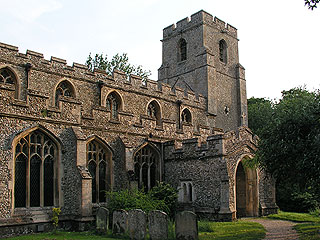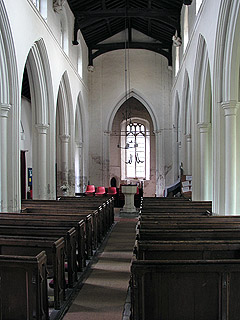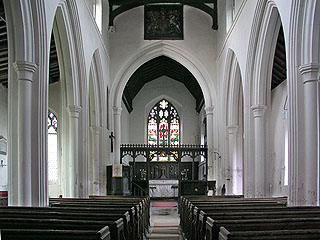It was about half past seven in the evening. It was the last day of May, 2003, and it had been a blazing summer day. The air was just starting to cool, which I welcomed, being a decidedly Northern European creature who doesn't enjoy the heat very much. We had seen 29 churches, our record, but the last few had been locked, and we were getting hungry. Still, 30 is a better number than 29, so we stopped off at Harston, not much expecting to get in.
The church is set deep in a leafy churchyard that was alive with evening birdsong. From the outside, it looks very splendid indeed - aside from the Victorian chancel, it's all a work of the Perpendicular period, built around 1445. The west tower has clasp buttresses at the corners (and once had a steeple according to Dowsing, who in 1643 ordered the removal of the cross from the top of it - a precarious task I expect), and the whole of the north side is decorated with battlements and a fine porch. There's also a lovely little pepper-pot turret housing the rood stair, which also has doors opening onto the nave and aisle roofs.
Inside, the church is big, though not so grand as one might imagine from the exterior. This is partially the result of the greenish glass which blights the clerestory, and fills the nave with a gloomy underwater light. I know that not everyone shares my taste in glass - I almost always prefer clear glass to anything coloured, unless it's really fine - but I'd challenge anyone to say that replacing this wouldn't be a vast improvement. Still, it's an interesting nave (the chancel is a rather dull, dark rebuilding which gave me the shivers a bit). The nave arcades are very unusual - the engaged columns and moulded arches are entirely within the thickness of the wall, with the result that the inner face is smooth and undecorated by carving from the ground to the roof. This accentuates the height of the nave - apparently there's only one other church like it, at Islip in Northamptonshire, according to the excellent church guide. The south aisle is unusually thin.
My favourite things were the corbels of the nave roof. They are complete figures, curled into little balls with their knees drawn up around their ears and clasping their shins.
Incidentally, Matthew Wren, uncle of Sir Christopher, was incumbent here from 1610-1634. Matthew Wren was master of Peterhouse in Cambridge from 1625-1634, and was responsible for the building of the grim chapel there. He had been chaplain to Charles I when the latter was Prince of Wales, and went on to be bishop successively of Hereford, Norwich and Ely. He was a protégée of Archbishop Laud, a dangerous thing to be in those days - and when his mentor was impeached, Wren ended up in the Tower of London from 1642-1660. He was restored to his see at the Restoration, and continued in that office until his death in 1667.
All Saints was open when we visited


